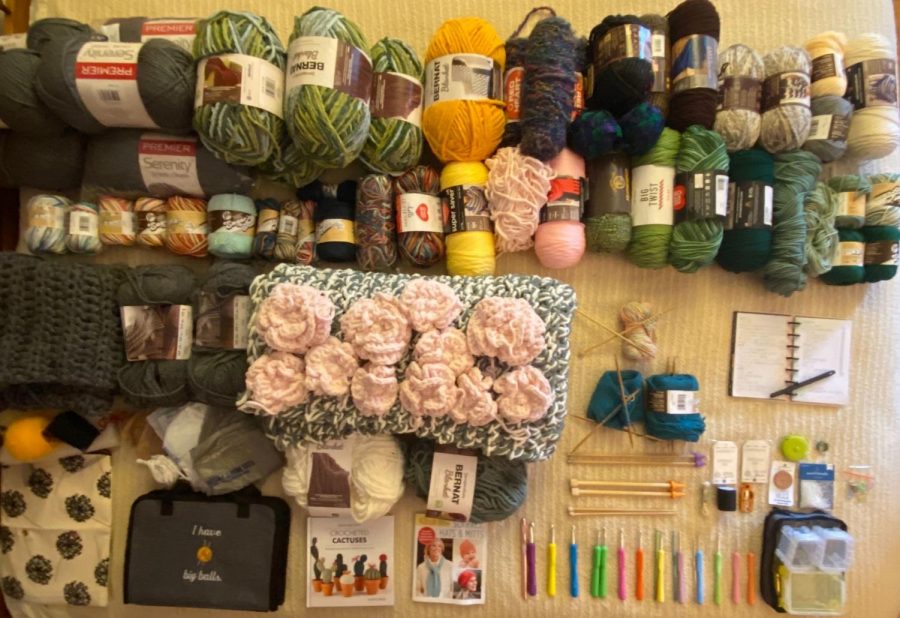How to get into Knitting/Crocheting
Columnist shares tips for yarn craft from firsthand experience
You don’t need all of this … at first.
June 12, 2020
Last year I was neck deep in debt, so broke I was nauseous, and dreading the impending doom of the holiday season. So I found some easy patterns online, brushed up on my knitting skills, and scraped through the holidays spending about $20 total on everyone’s gifts. I have great news for you:
You, too, can take the cheap way out of the holiday season!
What started as an easy holiday solution turned into a small business and a craft that feeds my soul (and a few Evergreen columns, too). I’m so taken with it that I always try to have a project on-hand because I use it as a meditation tool when my anxiety and stress is particularly high — and it’s nice to do something productive with that energy and focus on something else.
Getting started with yarn craft (the broader term for knitting and crocheting) can seem super daunting, but I hope what I’m about to tell you will help you get started. It’s really not as challenging as it seems! Plus, once you get going, you can make some genuinely thoughtful gifts and decorations for yourself.
Getting Started
The supplies you need are not cheap! But after years of buying yarn and tools, I’ve got some great tips for you to save some money. You can find knitting and crocheting items at Walmart, Michaels, JOANN, Moscow’s Yarn Underground and even Goodwill.
For needles, Yarn Underground has every size you could want and in bamboo (my preferred needle material, see more below in the ‘Knitting’ section). Yarn Underground also has a used section where you can get a pair for around $2. Michaels and JOANN have a lot of options, too, in plastic, metal and bamboo, but not necessarily in every size. Goodwill occasionally has needles, but they’re often metal. Walmart has some metal needle options, but very few (Walmart has many more options for crochet than knitting).
Yarn is not a competitive market, so the price at one store will typically be the same at another (but don’t forget to shop sales, which Michaels and JOANN frequently have). Walmart-brand yarn and Premier Yarn are very cost-effective and decent quality. If you want a particular color and material, Michaels and JOANN will be your best bet — they have aisles full of yarn.
Michaels, JOANN, Yarn Underground and Walmart all have accessories, with Walmart’s options being the cheapest and Yarn Underground having the most unique and interesting choices. The quality difference is obvious, but so is the price tag, so keep that in mind.
Knitting
Knitting is great for larger projects (like sweaters and scarves) and anything tube-shaped (like socks). I enjoy knitting because it takes both hands and it feels kind of rustic and cool to knit. I do like the texture of the average knitting stitch more than the texture of your common crocheting stitch because the material moves better. Cable knitting (those textures on cable-knit sweaters) is something I have not ventured into yet, but it’s something really cool I don’t think crocheting can do.
Needles: I’d recommend size 8 bamboo needles because this is the most common size and can be subbed for size 7 or size 9 if you need (your pattern will dictate what size). The size of your needle will determine the gauge, or stitches per inch, of your project. Bamboo needles are a little more expensive than metal or plastic needles, but the yarn won’t slide around as much, and I feel like I have better control over bamboo. (I learned how to knit on bamboo needles, though, so I may be biased.) Ignore the double-point needles and the needles connected by a plastic wire that you might see.
Yarn: For size 8 needles, you’ll want medium weight (size four) yarn. It’s called weight because yarn is frequently measured by its weight for thickness in patterns. There are weights from size one to size seven to accommodate projects like socks to blankets. Your pattern will also tell you the weight of yarn you should use, but medium size four is most commonly paired with size eight needles and is the most common yarn weight.
Accessories: Don’t let all the choices stress you out – this is the fun part!
- Stitch and round markers: Both are small and usually plastic. Stitch markers may be a good purchase to start with if you’re doing anything fancy and you can mark five or 10 rows as you follow your pattern. Round markers are round circles and best for knitting in the round (which is what you need double point needles for, which is probably not going to happen for your first project).
- Row/stitch counter: These usually come in the form of a clicker or a ring with rotating dials. I have the attention span of a squirrel and find these so helpful to keep me on track! There are cheaper options (simple plastic counter style) or the ring style, which is the one I have and got at Yarn Underground.
- Crochet hook: This is entirely optional, but if you drop a stitch it’s a good thing to have because it makes picking them up so much easier! I’d recommend size G.
- Tapestry/darning needle: These are the large sewing needles and come in a bunch of different sizes and in hard plastic, soft plastic and metal.
- Storage: Anything will work, you just need to store your yarn, needles and accessories.
- Small measuring tape: They make cheap retractable ones at Walmart and I love that they stay in a roll and don’t unravel.
- Needle tips: these are little rubber tips that will protect the points on your bamboo needles, keep your project on your needle, and keep your metal needles from poking your eye out when they’re not being used.
Advice: As you get started on your knitting journey, find a beginner’s book at your local Michaels, JOANN, or download one online. These will give you basic beginner projects, all of the stitches, how to do them and use layman’s terms instead of complicated ones.
People are also so creative and there are so many YouTube channels that have videos on how to complete stitches, steps or even full patterns if you get stuck. Also, check out YouTube videos on how to hold your needles in different ways. I started knitting as a child and stopped around junior high until just last year, and I still found a new needle position.
Also always check your gauge. The pattern will usually tell you what your gauge should be (for example: 20 stitches by 20 rows should be a 4-inch square).
Crocheting
I like crocheting more than knitting, mostly because it offers way more flexibility than knitting does. I’ve made succulents, flowers, leaves and you can even make little figures. I also like the single hook because it’s less complex. The fabric you crochet (with the same size hook/needle/yarn) will be stiffer and thicker than its knit counterpart, which is kind of a bummer, but upping your hook size will give you a more relaxed feel if it’s a deterrent.
Hooks: I’ve only used metal hooks, but there are plastic and wooden hooks, too. I’m not sure about the benefit of one over the other – but I would strongly suggest getting crochet hooks with ergonomic grips! Ergonomic grips are larger rubber handles on the needle to make it easier to hold the hook.
Crochet hooks commonly come in sets (this is less common for knitting needles) so you could buy a set. I’d recommend a size G or F hook since this is the most common size. There are millimeter measurements assigned to each letter and you can find conversion charts online to help. They do make light-up hooks if you have a hard time seeing, but they’re not cheap so start with a regular hook.
Yarn: I’d also recommend medium weight size four yarn, but try finding yarn that doesn’t separate as easily – yarn is made of four smaller strands wrapped together. When you crochet, if you have yarn strands that separate, it can drive you nuts!
Accessories:
- Stitch markers: As far as I can tell, you don’t need round markers in crochet, but stitch markers will come in handy to mark the ends of rounds and rows!
- Row/stitch counter (see above)
- Tapestry/darning needle (see above)
- Storage (see above)
- Small measuring tape (see above)
Advice: For some reason, crocheting was daunting to me, and it wasn’t until a knitting project required some basic crocheting that I decided to give it a shot. I find crocheting much more flexible and it allows for more creativity in patterns than knitting! Don’t give up or be discouraged, again there are great beginner books and videos on YouTube to help. There’s a really cute Star Wars crocheting kit set at Michaels right now that will help you from start to finish!
With crocheting I have some additional very specific pieces of information if you decide to pick it up, things that aren’t always explained in patterns:
- You will chain one, two, three or four after every single row you do, and the amount depend on the stitch you will be doing in that row: one is for single crochet, two for half double crochet, three for double crochet and four for treble crochet.
- You will also chain the appropriate amount after every round.
- “Joining in the round” means combining the end of the round to the beginning of the round, using a slip stitch.
- The things I just listed will make more sense as you start crocheting.
Arm Knitting/Finger Crocheting
This is a super fun alternative to using hooks and needles and you cover more ground quickly. This is the quickest option for blankets and I can arm knit a scarf in about an hour. There are some important things to note before you start with either.
Arm Knitting:
- Once you start, you can’t stop because the yarn is literally on your arms. You might be able to attach two Pringles cans together to hold them if you really need to stop (this is something I’ve seriously considered doing), otherwise just put them on one arm and carry the yarn with you!
- It’s the quickest form of yarn craft, but in my experience isn’t as clear as its needle counterpart.
- You either want to double up on bulky size five (definitely use two strands simultaneously), super bulky size six (consider using two strands simultaneously), or jumbo size seven.
- You cannot arm knit every knitting pattern.
Finger Crocheting:
- Your joints are going to get very tired, don’t give up! They do make gloves for joint discomfort related to this.
- You can set this project down.
- Keep your fingers spread so your stitches aren’t as tight (your yarn will go farther, too).
- You will want to use bulky size five to jumbo size seven yarn. If you use size five or six you don’t have to use two strands simultaneously, but you may want to consider it.
- You can finger crochet every crocheting pattern (but keep in mind you’ll need bigger yarn and the project will be much larger)!











